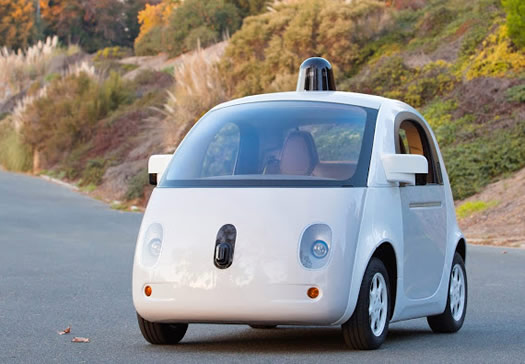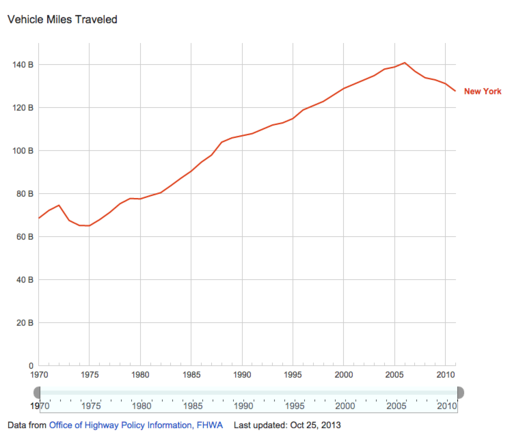Four trends shaping the way people will get around the Capital Region in the future

Google's prototype self-driving car. / photo: Google
Sometimes it's a good idea to take a step back and ask, "Where are we going?"
That's exactly what the Capital District Transportation Committee is doing right now for the Capital Region with its draft New Visions 2040 plan. It's trying to map out where we're all going (figuratively) and how we're all (literally) going to get there.
So, what does this sort of plan include? Roads, bridges, traffic congestion, CDTA, bike lanes, car sharing, road diets, all that stuff -- and things that are even farther out (both in the future and, like, whoa), such as self-driving cars.
CDTC has a bunch of public meetings coming up at which it's hoping people will speak up about their concerns and hopes for transportation in the future Capital Region. (Details are after the jump.)
So we thought it'd be interesting to talk with CDTC executive director Mike Franchini this week about four trends he thinks will influence how we'll get around in the future.
People are moving back to cities
The ongoing population growth of cities is a national trend, and while that sort of growth hasn't been as strong in the Capital Region, Franchini says it is starting to register here, too. After decades of population loss, Albany, Schenectady, and Troy all posted population gains in the 2010 Census.
"If [that growth] continues, it's going to make a major difference in how we plan transportation," Franchini said. Among the possible ways: growth in the cities could mean shifting some resources away from expanding capacity in suburban areas.
People are driving less

This is another national trend that started to catch a lot attention during the recession. And, some of the conventional thinking went, it would start to reverse itself after the economy picked up again. But that hasn't happened -- and the number of vehicle miles traveled has continued to fall.
"We're pretty confident people are driving less [in the Capital Region]," Franchini said. And like the population shift toward cities, this trend also points toward a potential shifts in funding, perhaps more toward transit and bike infrastructure.
Fewer people, especially younger adults, are buying cars and houses
Like a lot of these trends, it's hard to pin down the exact reason behind this shift. Is it because the economy? A lot of younger adults have struggled to find good jobs since the recession, even as they're weighed down by student debt -- not exactly a situation conducive for making large purchases. Or does this trend represent some other change, like an increased preference for other forms of transportation and on-demand resources like car sharing?
Franchini described what's happened so far as a "mode shift," manifested in part as an upswing in transit ridership -- both nationally and locally (CDTA has been registering record ridership in recent years).
Technological advances, especially self-driving cars
This one's more speculative than the first three, in large part because self-driving cars are still just starting out. Google's project is probably farthest along, and it still a prototype, years away from being available to the general public. (Not to mention that, tech aside, there will be a lot of regulatory and insurance issues to work out.)
But if the tech matures to the point it can be adopted on a large scale? "Self-driving cars are going to have a huge impact," Franchini predicts.
The nature of that impact is hard to totally forecast, though, because of how self-driving cars might intersect with other trends and tech. But Franchini offered a few thoughts, among them:
+ Self-driving cars hold the potential of being much less crash-prone than cars driven by humans -- in part because of technology like radar, in part because, you know, software doesn't get drunk or road rage-y -- so there could be a large effect on safety. And that, in turn, would have a huge effect on the very large number of people injured each year in crashes.
+ Because self-driving car tech is potentially more precise than a human driver, the cars could theoretically travel closer together at higher speeds (and avoid the cascading backups that occur when people keeping tapping their brakes). And that could mean less congestion, and reduce the need for increasing road capacity.
+ Self-driving cars could be a huge help for people with disabilities or the elderly.
But then there are possible effects that are harder to predict. For example: What does large-scale adoption of self-driving cars mean for transit usage -- especially if it's mashed up with on-demand car sharing or something like Uber? And does that self-driving car world mean more cars on the road... or fewer?
So there's some cloudiness here. But Franchini seems optimistic: "Most of the impacts [from self-driving cars] look pretty positive."
Franchini also mentioned a few other technological advances that might be (far out) ahead, including adaptive traffic signals that could make a difference in handling congestion, virtual in-car traffic signals that could help negotiate rights of way, and even stuff like drone delivery and solar roads that generate electricity.
CDTC New Visions public meetings
Here's the list of public information meetings for the CDTC's New Visions draft plan, which will include a short presentation, Q&A, interactive workstations:
March 12: Schenectady County Community College, Stockade Room 101, 6-8 pm
March 19: Sand Creek Middle School, Auditorium, 6-8 pm
March 25: Hudson Valley Community College, Bulmer Telecommunications Center Auditorium, 6-8 pm
March 31: Empire State Plaza, Meeting Room 6, 6-8 pm
April 7: Saratoga Springs City Hall, 3rd Floor Music Hall, 6-8 pm
Franchini stressed that the meetings really are about getting public feedback, and public comments will be cataloged and studied. So, if there's some local transportation issue you're concerned about -- whether it be traffic, bus routes, car sharing, bike lanes, road diets, whatever -- this is an opportunity to speak up.
Hi there. Comments have been closed for this item. Still have something to say? Contact us.
Comments
Completing the bike highway from Albany through Watervliet onto Troy, Cohoes and Waterford seems like such a no-brainer in light of the statistics, but it will probably be another 20 years before we have something resembling Best Practices or Complete Streets for that route. Prove me wrong, CDTC!
... said Ryan on Mar 10, 2015 at 7:47 PM | link
I think this video captures why the Capital Region needs to assess transportation funding priorities: http://www.streetfilms.org/americas-love-affair-with-great-city-streets/#more-57612
... said Leah Golby on Mar 11, 2015 at 8:07 AM | link
Right now can we just have decent cabs and bike lanes?
... said Cyril on Mar 11, 2015 at 9:26 AM | link
The legislation that created CDTA also includes a provision that Montgomery, Fulton, Greene, and Columbia counties can all join CDTA by having their county legislature vote to opt-in.
Doing so would:
- extend existing bus services (you'd be able to take the bus to Hudson!)
- reduce the costs of commuting to work (Amsterdam to Albany is currently $40 a WEEK)
- replace existing buses with low-carbon green fleets
- save the counties a couple of million dollars in total
- existing bus drivers would be hired by CDTA, so no jobs would be lost
The one caveat - the counties must also vote to allocate to CDTA a small percentage of their mortgage recording tax revenues (significantly less than their own bussing generally costs).
The reasons why the counties haven't done this yet:
- they don't know they can
- they think (erroneously) that it will reduce service
- they have beneficial relationships with the local bus companies that the counties contract their services with
... said Justin on Mar 11, 2015 at 9:53 AM | link
Pie in the sky vision: light rail connecting Albany, Schenectady, Troy, Saratoga and the airport.
Admittedly a remote possibility, this is probably how upstate NY cities need to think, given their economic stagnation (even regression) over the past 75 years or so.
Having lived in Minneapolis, I can attest light rail is truly a game changer.
... said Jilly Fuccillo on Mar 19, 2015 at 1:08 PM | link
As an almost one year old little one told me when i wanted to carry her all the time, while being her oh, so cautious nanny. "Feet go down"!
If you don't use your legs , you will lose their ability to move you around!
Use it ,or lose it!
... said mg on Mar 19, 2015 at 3:43 PM | link